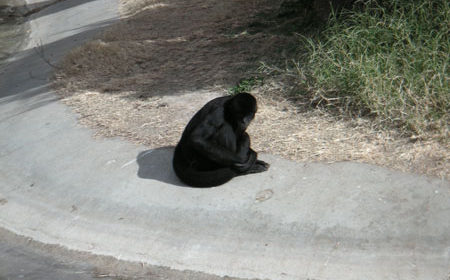ZOO-ILLOGICAL: A TRUE STORY

[This event really happened. The article first appeared in December, 2005, in a webzine that I had with my daughter. In view of the recent killing-by-rifle of a gorilla in a zoo in Ohio I dust this off and offer it here in desktodirt. Please do not attribute any political motives to this story: there aren’t any. In my case, respecting animals is non-partisan.]
After paying admission I walk through the El Paso Zoo turnstile, go over a bridge, and make a right turn. On the left is an authentic-looking peninsula of huge boulders with trees and thick Manila ropes draped between them. This is the home of beautiful pitch-black spider monkeys.
As I stand to admire them I see a woman visitor – thirty-something – at the water’s edge: The peninsula, you see, is surrounded by a three-foot wide moat. The monkeys must be hydrophobic, for there is nothing but a few feet and shallow water to keep them from jumping out and mingling with the guests.
Confident that she can get away with outrageous behavior, or she is simply too stupid to care, this woman is unabashedly giving the middle finger to our animal kingdom cousins sitting atop rocks.
That’s right, giving the offensive digit to monkeys at a public zoo.
And it isn’t done one-time as a joke – not that that would make it acceptable – since she repeats the gesture with a scowl, each time looking around as if expecting audience encouragement, if not participation.
(She must have taken a wrong turn off the highway on her way to the Jerry Springer Show.)
Just the attention – can they read sign language? – brings the monkeys down off the large rocks to ground-level, to a spot across the divide from their detractor.
Rooting for the animals I hope that one will defy their phobia and leap across the chasm and at least restyle this woman’s hair. I even think of becoming their ally by walking over to her and timing a well-intentioned trip that pushes her into the drink within reach of the monkey’s long arms. I guess the thought alone makes me an animal rights fanatic. One reason I don’t make any move – assault charges and jail being the major deterrents – is that there are young children in her party. Teach your children well, huh?
After this incident and as the cretin (no, not the monkey) and her family move along, I go out to my truck to get my trusty old 35 mm camera with telephoto lens. Upon return I invest a good half hour exchanging stares and generally communing with the creatures, taking a photograph now and then. They are so much like us. And, anthropomorphizing even more, their behavior, including yawns, says that they are bored stiff. I mean, how many times can they swing on the same rope, or arm-to-arm their way around a few hundred square feet of ersatz habitat, regardless how pristine and life-like it is?
What crime have they committed to deserve this? So I ask, in the year 2006, why do we have zoo’s with live animals? That is not to take anything away from the El Paso Zoo which, by the way is one of the cleanest, most animal-friendly with natural settings that I have ever seen. However, animals are not put on this earth to be caged, whether it is behind bars, two-inch thick Plexiglas, or water barriers. To make the point look at current movies with outstanding cinematic effects that wow paying audiences each year. (Have you seen the jungle-fighting in the most-recent celluloid reincarnation of King Kong? Tell me it isn’t real. Aren’t dinosaurs extinct?)
Why not dispense with the expense, care, feeding and caging of live animals and create digital zoos? They can even add 3 Dimension and its’ special glasses into the mix! Look at all the advantages this amazing technology brings!
An electronic zoo could be open longer hours since the resident population wouldn’t need to be absented for sleep, feeding and to be cared for. A portion of the admission charge would be dedicated to maintaining and increasing animal’s natural habitat’s worldwide. Zoo’s in the U.S. would have correspondent organizations in Africa, for example, and would channel those funds to them to buy and maintain protected land. The animals themselves would be able to stay and live free as Nature intends, and not literally be held captive living on welfare from their two-legged brethren, some of which deserve to be the ones in cages.
Of course zoo’s are the last refuge for keeping certain species from extinction. So, for those few but important animals, the museums would continue their programs of captive breeding, but without displays to the public. Minimizing their exposure to humans might get each animal back into its’ natural landscape more quickly with less animal culture shock.
And if you want to see the animals in their natural environment you can save your money and go on a photographic safari conducted by those same organizations that have correspondent arrangements with U.S. zoo’s.
Think it over. I bet the deciding factor – money – is there to be made as well.
[EdNote: The photo of the spider monkey is an original image, and is one of the monkeys mentioned.]
That was great, Dennis.